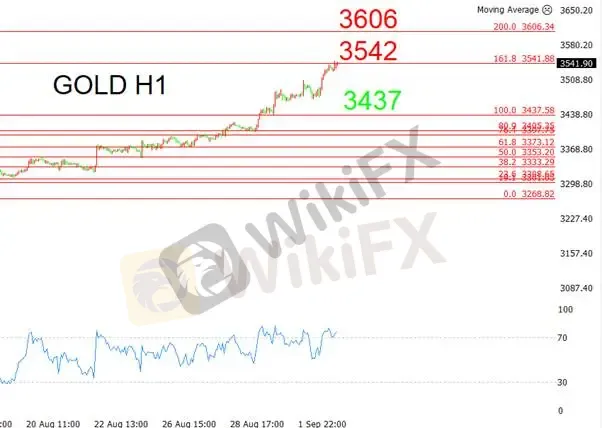简体中文
繁體中文
English
Pусский
日本語
ภาษาไทย
Tiếng Việt
Bahasa Indonesia
Español
हिन्दी
Filippiiniläinen
Français
Deutsch
Português
Türkçe
한국어
العربية
Bonds Are No Longer Safe: Flight to Gold as the New Haven
Abstract:The Federal Reserve‘s July minutes underscore a policy crossroads. Inflation remains above target, with tariffs adding upward pressure, while economic growth and labor momentum show signs of fatigue.
The Federal Reserve‘s July minutes underscore a policy crossroads. Inflation remains above target, with tariffs adding upward pressure, while economic growth and labor momentum show signs of fatigue. The Fed’s stance is cautious, data-dependent, and increasingly complex.
Growth Weakens
U.S. growth slowed in H1. GDP contracted in Q1 and only modestly rebounded in Q2. Consumer spending softened, housing investment fell, and net exports added growth mainly through front-loaded imports—unsustainable going forward.
Inflation Elevated
Headline PCE sits near 2.5% and core PCE around 2.7%, still above target. Tariffs are raising goods prices, while easing service inflation remains insufficient to offset overall pressure.
Labor Market Cooling
The unemployment rate holds at 4.1%, near full employment, yet cracks are visible. Job gains are concentrated, unemployment among certain groups is rising, and wage premiums for job-switchers are narrowing. Firms report caution, delaying both hiring and layoffs.
Market Signals
Financial markets look more optimistic. Large-cap tech stocks, lifted by AI enthusiasm, pushed the S&P 500 higher. Credit spreads narrowed, reflecting improved sentiment. Yet small-cap stocks lag, showing weak recovery breadth. Overall conditions remain accommodative.
Policy Risks
Minutes noted risks from high valuations, rising real estate loan defaults, bank exposure to rates, and stablecoin vulnerabilities. Tariffs dominated debate: some officials view them as one-off shocks, while others fear persistent inflation.
Most favored holding rates steady at 4.25%–4.50%, while Governors Bowman and Waller argued for a 25-basis-point cut, citing near-target inflation (ex-tariffs) and rising employment risks.
Balance Sheet and Liquidity
The Fed continues quantitative tightening but flagged short-term liquidity stress from Treasurys TGA replenishment. Standing Repo Facility usage hit record highs at quarter-end. The Fed pledged vigilance and readiness to support stability.
Outlook
The Fed faces twin challenges: tariff-driven inflation and softening employment. Elevated inflation would demand tighter policy, while weakening jobs could require easing. Stagflation would pose the toughest scenario.
The minutes set the tone for Jackson Hole. Chair Powell is expected to emphasize policy flexibility and anchoring long-term inflation expectations. The September meeting could mark a turning point, depending on data.
In short, the Fed cannot ignore inflation risks nor overlook employment pressures. The key message: patience and reliance on data.
Conclusion
Uncertainty leaves markets torn between inflation and growth. Short-term trades may prove volatile, but longer-cycle positioning offers greater resilience. Monetary purchasing power remains the decisive driver of gold—a principle unchanged for a century.
Gold Technical View

Gold stays in a descending channel, capped by $3,348–$3,350 resistance. Failure to break higher keeps the bearish bias intact.
Trend: Narrow downward consolidation dominated the weeks first four sessions; weekly and daily charts remain weak.
Catalyst: Todays central bank symposium could trigger direction.
Strategy: Shorts should hold strict stop-losses; flat traders may consider fresh shorts in Asia hours.
Stop-loss: $15
Support: $3,311 / $3,313
Resistance: $3,348 / $3,350
Disclaimer: Analysis is for general commentary only, not investment advice. Traders bear full responsibility for decisions.
Disclaimer:
The views in this article only represent the author's personal views, and do not constitute investment advice on this platform. This platform does not guarantee the accuracy, completeness and timeliness of the information in the article, and will not be liable for any loss caused by the use of or reliance on the information in the article.
WikiFX Broker
Latest News
Fake Trading Platforms Are Spreading Fast Across Asia | How Investors Are Being Tricked
WikiFX Elites Club Committee Concludes Voting! Inaugural Lineup Officially Announced
eToro CopyTrader Expands to U.S. Investors
Is MH Markets Safe or a Scam? Regulation and Fund Security Explained
Ponzi Scheme Operator Sentenced to 14 Years in Western Australia
Chicago PMI Beats But Remains In 'Contraction' For Second Straught Year
How to Add and Take Out Money from Amillex Broker: A Complete Guide
T4Trade broker Review 2025: Is T4Trade Regulated?
FCA warning: These Firms are on the list
Don’t Get Scammed: A Roundup of Common Online Fraud Tactics in Forex
Currency Calculator



